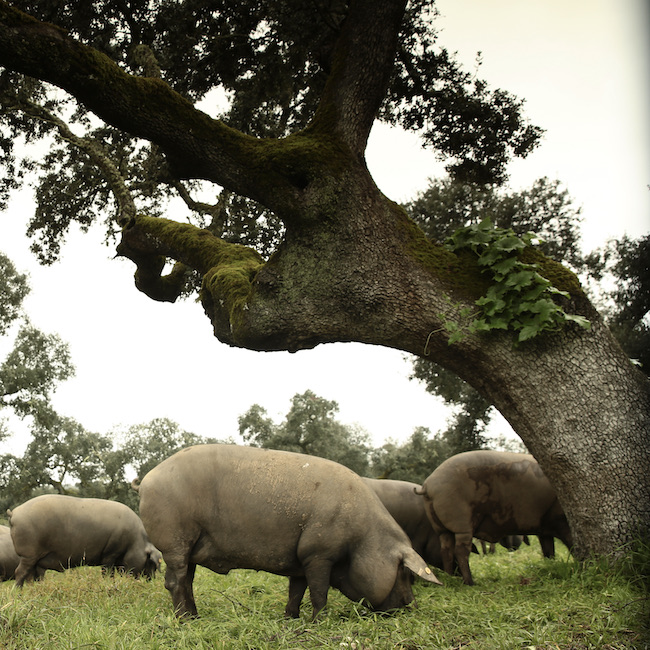.png.transform/rendition-xs/image_image%20(1).png)
My True Love for Acorn-fed Ibérico Ham by Chef Katie Button
Chef Katie Button, who owns Cúrate restaurants in USA, writes a love letter to this unique high-quality product.
I often refer to jamón ibérico de bellota as “the Rolls Royce of hams,” to relay how singular it is to guests that are unfamiliar with it in our restaurants. At Cúrate, we have an entire section of the restaurant that is dedicated to display both hanging jamón Ibérico, and a carving station, where we hand cut each prized jamón for service. Sharing this product with our community, telling its history and distinguishing characteristics is incredibly important to the Cúrate crew. It’s something that we know differentiates our restaurant, and something guests look forward to experiencing each time they come in. We are working to recreate the feeling of Spain’s jamonerías - stores dedicated to the product, where whole legs, cured sausages, and more are hanging for patrons to shop and purchase - there’s something about seeing a whole cured leg of ham that feels grand and sacred at the same time.

To start at the beginning, the ibérico breed hails from the Iberian peninsula - thus the name. The breed is also sometimes called pata negra (black foot), referring to pig's color and the hoof that accompanies each whole ham. As a descendent of wild boars of the Mediterranean, these pigs are active animals and spend their days running and rooting. The structure of their intramuscular fat is unique, resulting in meat that is highly flavorful, juicy, and distinctive.
The dehesa is an undeniably idyllic environment. I visited my first dehesa on a trip to Spain with my husband and business partner, Félix Meana in 2013. To paint a picture of the lives of ibérico pigs, imagine wandering through a grassy pasture through dappled sunlight from oak and cork trees, rustling leaves and acorns beneath your feet, taking your time to root through the abundant forage - maybe stopping for a nap in the shade. This is the life of the ibérico pig and the building blocks to the superior flavor in the end product.
Officially, in the world of ibérico pork, a dehesa is a wooded pasture with at least 10 trees per hectare. Generally, from October to early March is acorn season in the dehesa. From smell to taste, the acorns impart the defining taste of a top-grade jamón ibérico - an aromatic combination of sweet, nutty, and earthy. The fat-rich acorns also lend to the soft, melty fat marbling that makes jamón ibérico unforgettable. When the pigs are in the midst of acorn season, they double their weight in about 3-4 months.
From black to white: the ham grades
Often, we’re asked about the differences between the jamón Ibérico offerings in our restaurants and through our online marketplace - from price to flavor to breed. In 2014, Spain established a color-coded model to help consumers understand what they’re purchasing. The intent behind these designations is to protect the process, breed integrity and methodology that are the true differentiators in quality. The "black label" jamón ibérico de bellota is the finest quality. The designation is reserved for pure-bred Iberian pigs, which are, fittingly, black in color. To obtain this designation, pigs must also be free range and acorn-fed roaming a dehesa. The next step down is "red label" jamón ibérico de bellota, which applies to free-range pigs fed on the acorn diet that are not pure-bred Iberians, though details about their percentage of Iberian ancestry must appear on the label. These pigs must be a minimum of 50% ibérico. The"green label" jamón Ibérico refers to pastoral pigs whose diet includes grains in addition to the acorns. These pigs are also at least 50% Iberian by heritage. They are often referred to as jamón ibérico cebo de campo. This dietary change results in major differences in flavor and composition of the meat. White Label. The "white label," conferred to pigs fed a diet of grain. These pigs also don't necessarily need to be free-range at this level.
You may be wondering, where does jamón serrano fit in? Serrano refers to any of a group of breeds that aren’t ibérico, such as Landrace or Duroc. These animals are easier to breed, and produce larger litters - essentially, they are a better fit for modern farming practices.

The process
To begin the curing process, the ibérico pig is slaughtered humanely (or "sacrificed" as is common to say). Salting, resting and dry curing make up the remainder of the process. Submerged in sea salt, the ham rests at low, humid temperatures for a short period of time - usually about 10 days - so the salt can seep in and properly dehydrate the meat, killing any microorganisms along the way.
After salting, the jamón needs to rest for a period to mature. During this phase of the process, heat and humidity are regulated by the producers - sometimes with simple methods such as soaking the floor in water. Basically, at this point, the ham has lost moisture, and develops an exterior mold that protects it from spoilage.
The last step is to hang the jamón in a cellar to age. This is where the best flavors begin to develop. During one amazing trip to Jabugo, Spain - the epicenter of jamón production - I was able to tour the section of a jamón cellar dedicated to Cúrate’s jamón Ibérico - it was incredible! While there, I learned that the very best black label jamón Ibérico is inspected frequently and carefully by a specialist who decides when it is perfectly ready to be sold and enjoyed. Jamón ibérico is a product that is truly unique to the culinary world because it’s tied in with centuries-old traditions and a distinct area of Spain. We’re so proud to bring it to our guests, honor the producers who are keeping the traditions alive, and transport people to Spain with every delicious bite.

